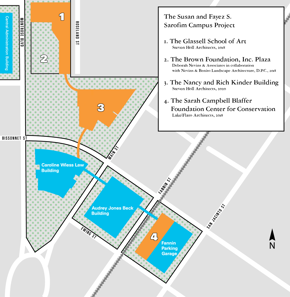Campus Redevelopment
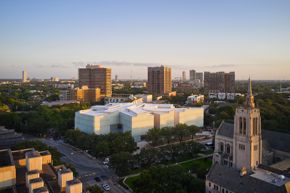
The Nancy and Rich Kinder Building at the Museum of Fine Arts, Houston, from above. Photo by Peter Molick / Thomas Kirk III
The Museum of Fine Arts, Houston
The Susan and Fayez S. Sarofim Campus
The campus of the Museum of Fine Arts, Houston, has been transformed with a school and gallery building, designed by Steven Holl Architects; a conservation center, designed by Lake|Flato Architects; and a landscape plan by Deborah Nevins & Associates that knits together a century’s worth of signature architectural structures. The entire project, underway since 2012, was completed with the opening of the Nancy and Rich Kinder Building on November 21, 2020.
Questions about the campus redevelopment? Contact expansion@mfah.org or 713.830.5280.
The Susan and Fayez S. Sarofim Campus
Encompassing 14 acres in the heart of Houston’s Museum District, the MFAH campus-redevelopment project is a major contribution to the city’s efforts to improve the pedestrian experience of Houston. With an array of public plazas, reflecting pools, and gardens, as well as improved sidewalks, street lighting, and way-finding, the Susan and Fayez S. Sarofim Campus provides an active setting for three significant new structures:
• A 237,213-square-foot-building for 20th- and 21st-century art: The Nancy and Rich Kinder Building
• A 102,528-square-foot home for the Museum’s school: The Glassell School of Art
• A 37,864-square-foot, state-of-the-art conservation center: The Sarah Campbell Blaffer Foundation Center for Conservation
Additional key elements
• Two underground parking garages
• Two pedestrian tunnels: one between the Nancy and Rich Kinder Building and the Caroline Wiess Law Building, and one between the Glassell School of Art and the Kinder Building
• A renewed Cullen Sculpture Garden; designed by Isamu Noguchi, it has been restored as part of the campus project
The Nancy and Rich Kinder Building
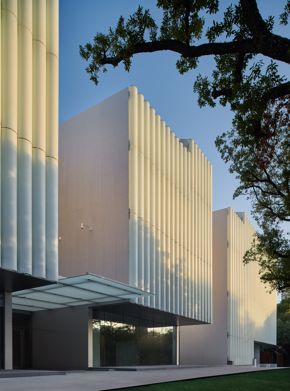
The Nancy and Rich Kinder Building at the Museum of Fine Arts, Houston. Photo by Peter Molick
Aerial view of the Nancy and Rich Kinder Building Steven Holl Architects. Photograph © Richard Barnes
Steven Holl Architects, luminous canopy of the Nancy and Rich Kinder Building, watercolor
Designed by Steven Holl Architects
Opening Day: November 21, 2020
The translucent Nancy and Rich Kinder Building, dedicated to art after 1900 from the MFAH collections, stands in complementary contrast to the Ludwig Mies van der Rohe–designed Caroline Wiess Law Building (1958/74) and stone facade of Rafael Moneo’s Audrey Jones Beck Building (2000).
Architecture Highlights of the Nancy and Rich Kinder Building
- Gathered under a “luminous canopy” roof, the concave curves reference the billowing clouds that fill the “big sky” of Texas
- Vertical, translucent-glass tubes cladding the facades
- Two floors and more than 100,000 square feet of exhibition space circling a three-level atrium space, with the distinctive roof allowing natural light to flood the central spaces
- Increases overall MFAH exhibition space by nearly 75 percent
- The 215-seat Lynn Wyatt Theater; a restaurant; and a café
- Seven gardens and six reflecting pools inset along the building’s perimeter
Art Highlights of the Nancy and Rich Kinder Building
- Dedicated to presenting works from the Museum’s international collections of modern and contemporary art
- Opens with the first comprehensive installation of these works, drawn from the collections of Latin American and Latino art; photography; prints and drawings; decorative arts, craft, and design; and modern and contemporary art
- A flexible black-box gallery at the street-level entry of the building is permanently devoted to immersive installations, with inaugural presentations of the work of Yayoi Kusama, Gyula Kosice, and James Turrell
- The second-floor galleries are organized by curatorial department; each highlights collection strengths
- The third-floor galleries feature Connecting Currents: Contemporary Art at the Museum of Fine Arts, Houston—five inaugural thematic installations that present art from the 1960s onward
See previews of collection highlights and the inaugural thematic installations.
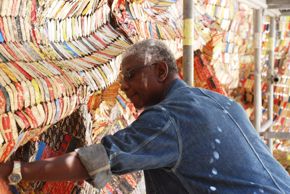
El Anatsui
Courtesy of the artist
Byung Hoon Choi
Courtesy of the artist
Carlos Cruz-Diez in the Chromosaturation of the Chroma exhibition, 2017, SCAD Museum of Art, Savannah, Georgia.
© ADAGP Paris 2019 © Photo: Articruz S.A.
Olafur Eliasson
Photo: Brigitte Lacombe 2016
© 2016 Olafur Eliasson
Trenton Doyle Hancock
Courtesy of the artist
Cristina Iglesias
Courtesy of the artist
Ai Weiwei, 2012
Courtesy of Ai Weiwei Studio
Site-Specific Commissioned Artworks
A series of major site-specific commissioned artworks, inaugurated with the Kinder Building, serve as portals that connect the new structure with the other components of the Sarofim Campus. Located at strategic points, the works are designed to mark moments of transition on the campus and activate public spaces. These works of art have been commissioned from a roster of renowned, international artists.
- El Anatsui
- Byung Hoon Choi
- Carlos Cruz-Diez
- Ólafur Elíasson
- Trenton Doyle Hancock
- Cristina Iglesias
- Jason Salavon
- Ai Weiwei
The Glassell School of Art & The Brown Foundation, Inc. Plaza
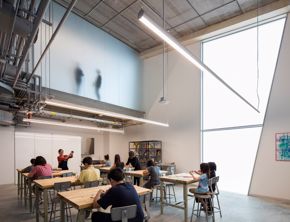
A studio classroom inside the Glassell School of Art. © Richard Barnes
The Glassell School of Art © Richard Barnes
Forum of the Glassell School of Art
© Richard Barnes
Steven Holl Architects, Glassell School of Art watercolor. Courtesy of Steven Holl Architects.
Designed by Steven Holl Architects, with plaza designed by Deborah Nevins & Associates in collaboration with Nevins & Benito Landscape Architecture, D.P.C.
Completed 2018
The L-shaped Glassell School of Art building is constructed from nearly 200 sandblasted, pre-cast concrete panels, alternating with panes of glass, in a rhythm of verticals and slight angles.
Highlights of the Glassell School of Art
• The PNC Roof Garden, a sloping, walkable green roofline offering dramatic views of the Sarofim campus and the Houston skyline
• Fronts onto The Brown Foundation, Inc. Plaza, with its ample outdoor space for programs and performances, and two significant works of public sculpture: Cloud Column (2006) by Anish Kapoor and Song of Strength (1966) by Eduardo Chillida
• A street-level café for students and the public
• Provides studio and classroom space for Glassell School of Art students from pre-K to post graduate
The Sarah Campbell Blaffer Foundation Center for Conservation
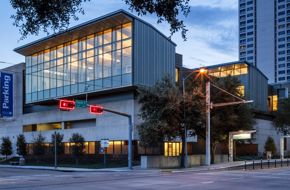
Evening view of the Sarah Campbell Blaffer Foundation Center for Conservation by Lake|Flato Architects. Photograph © Richard Barnes
Designed by Lake|Flato Architects
Completed 2018
Constructed on top of the pre-existing Binz Street parking garage, the Sarah Campbell Blaffer Foundation Center for Conservation houses state-of-the art conservation labs and studios.
Highlights
• Brings the MFAH conservation team together under one roof and in close proximity to the Museum
• Provides facilities not only for MFAH research and conservation projects, but also for national and international collaborations
#MFAHTransforms
Time-Lapse: Anish Kapoor’s Cloud Column
The Brown Foundation, Inc. Plaza & PNC Roof Garden

